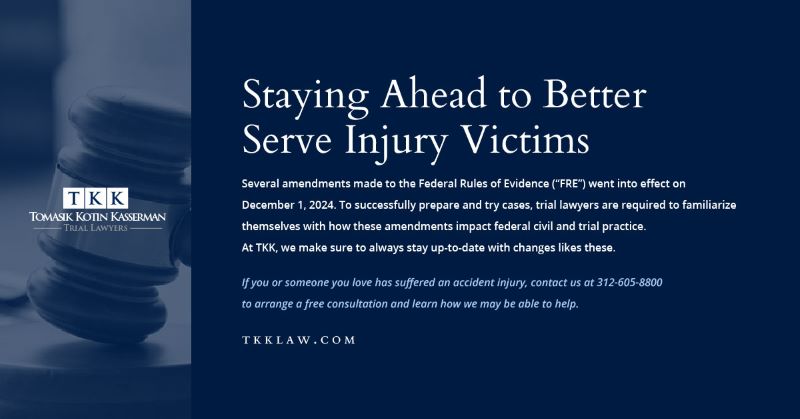New Amendments to the Federal Rules of Evidence That Every Trial Lawyer Needs to Know
By Timothy S. Tomasik
January 13, 2025

Several amendments made to the Federal Rules of Evidence ("FRE") went into effect on December 1, 2024. To successfully prepare and try cases, trial lawyers are required to familiarize themselves with how these amendments impact federal civil and trial practice.
The Amendments Significantly Distinguish Illustrative Aids From Demonstrative Evidence
FRE 107 is titled "Illustrative Aids." In prior practice, Illustrative Aids, such as diagrams or drawings used or made by a witness, were most commonly deemed "demonstrative evidence." The recent changes made to FRE 107 make clear that illustrative aids and demonstrative evidence are not interchangeable per the application of the FREs. The committee notes regarding the new amendments explain that an illustrative aid is not evidence but rather a "presentation" to assist the jury in understanding the evidence, while demonstrative evidence is the actual substantive evidence offered to prove a disputed fact." FRE 107 provides that illustrative aids used at trial should be entered into the trial record whenever practicable (FRE 107(d)).
The danger of improperly conflating these two terms may ultimately impact the jury's ability to review meaningful evidence during deliberations. Demonstrative evidence, after being admitted during trial pursuant to the Court's discretion, is available to jurors to review during deliberations. By the same measure, Illustrative evidence will only be evaluated in the jury room if all parties agree or if the court finds good cause. Still, the revisions to FRE 107 makes it clear that an illustrative aid must be entered into the record whenever practicable (FRE 107(c)).
Summaries of Voluminous Materials Are Admissible
FRE 1006 regulates the use of simplified summaries of voluminous complex documents and data. Now, summaries of "voluminous evidence" are admissible, even if the underlying materials have not been admitted (FRE 1006(a)). For example, a summary of thousands of pages of medical records can be admitted and used at trial, even if the actual records have not been admitted. As a prerequisite, the rule requires disclosing all of the underlying materials to opposing parties. When used properly, this rule change has the ability to make document-intensive litigation more efficient. Lawyers are more free to efficiently shorten witness testimony and avoid juror inattentiveness by using summaries. The rule clarifies that summaries, charts, or calculations of voluminous materials are admissible as actual evidence.
Amendment to FRE 613 Allows Witnesses to Explain Prior Inconsistencies on Direct Exam
The revisions made to FRE 613 were small but quite mighty. Lawyers are now given the ability on direct examination to have a witness explain or deny a prior inconsistent statement before extrinsic impeaching evidence is introduced on cross examination. Hence, a witness who takes the stand and testifies inconsistently with his or her prior deposition testimony may explain the inconsistency on direct examination before the opposing attorney proceeds with impeaching the witness on cross examination. Comments to the amendment explain "this ensures fairness in impeaching witnesses while preserving the integrity of their testimony." In practice, this change will require lawyers to more strategically prepare for direct and cross examination. In many circumstances, this amendment substantially impacts the ability of opposing counsel to formidably attack the credibility and bias of a witness on cross examination.
When a New Entity Stands in the Shoes of the Original Declarant, the Statements are Admissible Against the Successor Entity
Under FRE 801(d)(2), a statement made by the predecessor-in-interest of a party-opponent is now admissible as non-hearsay against the declarant's successor-in-interest. This change will allow more flexibility in introducing prior statements in succession-related cases. Plainly stated, this amendment makes clear that when a new party stands in the shoes of the declarant or original principal, statements made by the declarant or principal are admissible against the successor party (FRE 801(d)(2)). It is incumbent on every trial lawyer to understand that party "statements" (previously known as "party opponent admissions") are not exceptions to the hearsay rule; rather, these statements are admissible as non-hearsay.
Statements Against Interest in Criminal Cases Require Corroboration for Admissibility
The evidentiary standard in criminal matters for allowing statements against interest made by unavailable witnesses has changed under 804(b)(3). Now, the court is required to consider the "totality of the circumstances" under which the statement was made and evaluate any evidence that may undermine it. Comments to the revisions explain an intent to force courts that have previously failed to consider independent evidence supporting or casting doubt on the proposed statement to do so. In practice, preparing credible corroborative evidence is a sound strategy to ensure that a statement gets fairly admitted pursuant to this revision of the rule. It is equally true that for the opponent attaching corroboration, it is mandatory to undermine any corroboration.
About Timothy S. Tomasik
Tim Tomasik is a Past President if the Chicago Bar Association, Past President of the American Board of Trial Advocates IL Chapter, a fellow of the International Society of Barristers Board of Governors, a Fellow of the American College of Trial Lawyers, and a member of the Illinois Supreme Court Committee on the Illinois Rules of Evidence. Contact Tomasik Kotin Kasserman, LLC at 312-605-8800.
TKK blog Center
October 16, 2025 in Personal Injury
How Can a Personal Injury Attorney Help After a Refinery Accident?
Read MoreSeptember 17, 2025 in Personal Injury
Back to School: Are Universities Liable for Student Injuries?
Read MoreAugust 15, 2025 in Personal Injury
Suing for Amputations, Burns, and Other Catastrophic Injuries in Illinois
Read More









